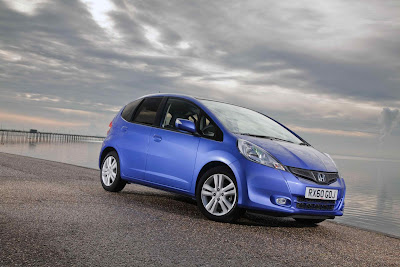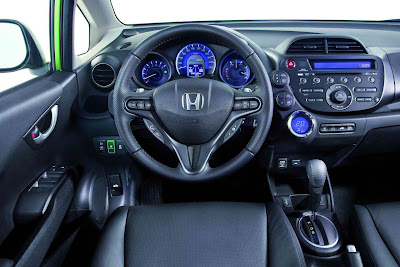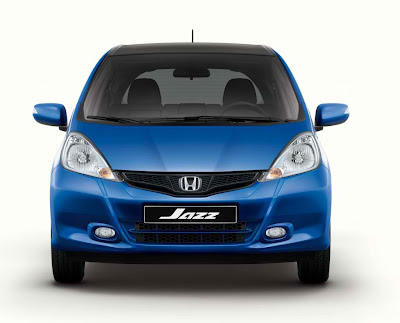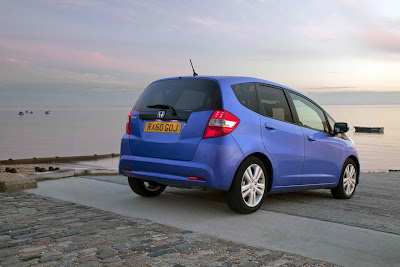The addition of the Honda Civic Hybrid, the rest of the collection of some of the Jazz design and details of changes to improve its already strong in the B segment, power of attorney.
Over 500,000 customers have felt the benefits of an innovative cross-sector, the Honda Jazz and selects only the most recent changes to improve the experience. The main objective was to maintain key customer benefits of flexibility, convenience, reliability and fuel economy, emissions, comfort and style.
TRANSMISSION
One of the biggest changes is the return of the Honda Jazz CVT range with the first European to use another form of variable transmission. The CVT in the Honda Jazz has been improved by installing a torque converter box, resulting in greater efficiency and better control at low speed.
The use of a tilt sensor allows the box to decide when the car needs to be carefully creep forward, and when it will not help the driver maintain maximum control. The CVT-based proved very popular in the previous generation Honda Jazz, and his return was prompted by a request for loyal customers who enjoyed its smooth shifting characteristics and easy driving.
This transmission is different, as used in the hybrid model Honda Jazz, for its various needs, do not accept units of torque converter.
CVT gearbox is equipped with paddles behind the steering wheel when the driver manual control. If used in "D", the blades can bring the car lower the ratio, because the effect of "kick down", a box to return to the automatic transmission later. When the paddle is used the mode "S", allows full manual control over the selection ratio, the acceleration or engine braking. Manual transmission remains unchanged in the five-speed transmission of noise and economy for cars.
Exterior design
External changes are made to the car, both to improve the look of the car and reduce drag to improve fuel economy. The front bumper and rear are the most important area where aesthetics and aerodynamics have both influenced the new look of the car. They are designed to reduce drag as the air stream passes over the body and Honda Jazz to avoid turbulence which stands out from the back.
The grille and headlights have been modified to give a new face to the 1, 2 and 1.4 liter versions of the car. The rear lights have also been modified to include a larger area of ??red lentils and better distinguish the clean gasoline cars of the hybrid Honda Jazz. Two new colors join the line Jazz in 2011 with a bronze medal brilliant Deep Blue Sapphire and ionized, a metallic brown to complement the revised guidelines.
One of the biggest changes is the return of the Honda Jazz CVT range with the first European to use another form of variable transmission. The CVT in the Honda Jazz has been improved by installing a torque converter box, resulting in greater efficiency and better control at low speed.
The use of a tilt sensor allows the box to decide when the car needs to be carefully creep forward, and when it will not help the driver maintain maximum control. The CVT-based proved very popular in the previous generation Honda Jazz, and his return was prompted by a request for loyal customers who enjoyed its smooth shifting characteristics and easy driving.
This transmission is different, as used in the hybrid model Honda Jazz, for its various needs, do not accept units of torque converter.
CVT gearbox is equipped with paddles behind the steering wheel when the driver manual control. If used in "D", the blades can bring the car lower the ratio, because the effect of "kick down", a box to return to the automatic transmission later. When the paddle is used the mode "S", allows full manual control over the selection ratio, the acceleration or engine braking. Manual transmission remains unchanged in the five-speed transmission of noise and economy for cars.
Exterior design
External changes are made to the car, both to improve the look of the car and reduce drag to improve fuel economy. The front bumper and rear are the most important area where aesthetics and aerodynamics have both influenced the new look of the car. They are designed to reduce drag as the air stream passes over the body and Honda Jazz to avoid turbulence which stands out from the back.
The grille and headlights have been modified to give a new face to the 1, 2 and 1.4 liter versions of the car. The rear lights have also been modified to include a larger area of ??red lentils and better distinguish the clean gasoline cars of the hybrid Honda Jazz. Two new colors join the line Jazz in 2011 with a bronze medal brilliant Deep Blue Sapphire and ionized, a metallic brown to complement the revised guidelines.
INTERIOR
Within the most notable change is the adoption of a dark material panel in a single color that is combined with a new seat fabric for a better atmosphere in the cabin. Dashboard lights are now united in a single color orange, which gives a striking contrast with the dark dashboard. Chrome rings now define vents, instruments, climate control and display (if installed). For the first time in Europe, Honda Jazz, the leather seats are optional factory installed.
Magic Seats
One of the most distinctive jazz currentHonda and a key factor for its popularity is the magic seats acclaimed for its flexibility and multiple configurations of seating and cargo. The new Jazz reserves no surprise, but the agreement is now even better with the addition of a tilt feature. This new feature gives customers a greater level of flexibility, convenience and to complement and excellent leg room for rear passengers.
The rear seats of the Honda Jazz completely flat, giving a very low cargo floor, it is possible that due to the setting tank Honda Center, which is shared with the European Civic. The base of the seats fall into the space normally filled with fuel tank, located under the front seats, no usable space in the back. The front seats are not to be pushed forward to allow enough space back when it is folded. Instead, even with front seats in their rearmost position, the rear seats, with their 60:40 retractable headrests be transformed into a simple "movement" diver-down action by means of a lever located on the seat outside shoulder.
Utility mode Jazz "Honda offers a completely flat load floor up to 1720 mm long enough to swallow three 26 inch mountain bikes with front wheels are still tied up. The current area is equivalent to two large Samsonite suitcases two very large planes, and three golf bags can be placed along. With the wider rear just collapsed, there is sufficient space and length to accommodate a surfboard flat, or two 26-inch bike Mountain upright. The available load length is even greater in the "Long Mode" where you slide the front passenger seat fully forward and fully tilted his record - an open cargo area of ??2.4 m long . With the seats folded capacity increases to start Honda Jazz 1320 liters of space when measured on the roof and ground storage.
To return the rear seats of a seat, simply lift the assembly back seat stuck in the back seat and is simply released by pulling part of the legs and the seat folded down.
Within the most notable change is the adoption of a dark material panel in a single color that is combined with a new seat fabric for a better atmosphere in the cabin. Dashboard lights are now united in a single color orange, which gives a striking contrast with the dark dashboard. Chrome rings now define vents, instruments, climate control and display (if installed). For the first time in Europe, Honda Jazz, the leather seats are optional factory installed.
Magic Seats
One of the most distinctive jazz currentHonda and a key factor for its popularity is the magic seats acclaimed for its flexibility and multiple configurations of seating and cargo. The new Jazz reserves no surprise, but the agreement is now even better with the addition of a tilt feature. This new feature gives customers a greater level of flexibility, convenience and to complement and excellent leg room for rear passengers.
The rear seats of the Honda Jazz completely flat, giving a very low cargo floor, it is possible that due to the setting tank Honda Center, which is shared with the European Civic. The base of the seats fall into the space normally filled with fuel tank, located under the front seats, no usable space in the back. The front seats are not to be pushed forward to allow enough space back when it is folded. Instead, even with front seats in their rearmost position, the rear seats, with their 60:40 retractable headrests be transformed into a simple "movement" diver-down action by means of a lever located on the seat outside shoulder.
Utility mode Jazz "Honda offers a completely flat load floor up to 1720 mm long enough to swallow three 26 inch mountain bikes with front wheels are still tied up. The current area is equivalent to two large Samsonite suitcases two very large planes, and three golf bags can be placed along. With the wider rear just collapsed, there is sufficient space and length to accommodate a surfboard flat, or two 26-inch bike Mountain upright. The available load length is even greater in the "Long Mode" where you slide the front passenger seat fully forward and fully tilted his record - an open cargo area of ??2.4 m long . With the seats folded capacity increases to start Honda Jazz 1320 liters of space when measured on the roof and ground storage.
To return the rear seats of a seat, simply lift the assembly back seat stuck in the back seat and is simply released by pulling part of the legs and the seat folded down.
This will lock the seat base, add innovation and unique offerings Honda Jazz, as in "Grand mode" of the seat bases can be closed up and left against the seat backs, creating a second cargo area between the front and rear, capable of accommodating a variety of objects up to 1280 mm in height, such as plant height, two mountain bikes with their front wheels removed, a folded wheelchair, and all kinds of other things. And since the rear doors now open wider, which is even easier to make full use of this feature.
Double-Trunk boot
The same levels of innovation found in the luggage bay of the new Honda Jazz, which still offers a first-class ability, which improves some compact MPV segment B.
Under the cargo floor is a storage compartment and secondary models 1.4 the provision of a tire repair kit instead of a spare wheel space frees this space, adding an additional 64 liters to give a capacity of exceptional 399 liters (VDA), compared with 380 liters of the previous-generation Honda Jazz (9 liters below the floor space savings of the wheel).
Practice the system boot, dual trunk-mounted 1.4-liter Honda Jazz models with puncture repair kit, providing greater comfort for homeowners and perfectly complement the Magic seats arrangement.
In the area of ??"standard" under the floor storage is hidden by a panel of 100 kg capacity, double hinge. This panel can be folded against the rear seat mode "tall to use the full depth of the cargo space for large objects, especially for transportation.
Otherwise, instead of folding the complete panel against the rear seat backs, its rear half can be lifted in a horizontal position, and can be supported by aircraft on the side of the cargo bay, to create a platform half-height storage and effectively separate the cargo space in upper and lower sections - the so-called "upper / lower Mode." content network in the top panel is perfect for carrying irregularly shaped objects that do not stay flat.
The same levels of innovation found in the luggage bay of the new Honda Jazz, which still offers a first-class ability, which improves some compact MPV segment B.
Under the cargo floor is a storage compartment and secondary models 1.4 the provision of a tire repair kit instead of a spare wheel space frees this space, adding an additional 64 liters to give a capacity of exceptional 399 liters (VDA), compared with 380 liters of the previous-generation Honda Jazz (9 liters below the floor space savings of the wheel).
Practice the system boot, dual trunk-mounted 1.4-liter Honda Jazz models with puncture repair kit, providing greater comfort for homeowners and perfectly complement the Magic seats arrangement.
In the area of ??"standard" under the floor storage is hidden by a panel of 100 kg capacity, double hinge. This panel can be folded against the rear seat mode "tall to use the full depth of the cargo space for large objects, especially for transportation.
Otherwise, instead of folding the complete panel against the rear seat backs, its rear half can be lifted in a horizontal position, and can be supported by aircraft on the side of the cargo bay, to create a platform half-height storage and effectively separate the cargo space in upper and lower sections - the so-called "upper / lower Mode." content network in the top panel is perfect for carrying irregularly shaped objects that do not stay flat.
The 230 mm deep in space is ideal for storing sports gear or raincoats and umbrellas and once the cap is, keeps separate soiled items other luggage.
The loading lip 605 mm from the ground makes for easy loading and unloading.
Finally, a handy shopping bag hook is located just inside the left side of the bay luggage.
The loading lip 605 mm from the ground makes for easy loading and unloading.
Finally, a handy shopping bag hook is located just inside the left side of the bay luggage.
REVISIONS CHASSIS
Suspension Honda has revised the legislation to increase the ride comfort and handling. To complete the comfort best guide, a review model has been further enhanced to improve the resistance of the additional "on-center" feel, giving greater handling.
ENVIRONMENTAL INFORMATION
To complement the launch of the hybrid of jazz, jazz conventionally powered Honda has also been some small reductions in the values ??of CO2 and fuel economy. The new CVT gearbox linked to the economy and emissions last year I-Shift 1.4-liter model with a CO2 value below the manual model of only 125 g / km. The 1.2-liter car now emits just 123 g / km of CO2 and fuel use 5.3 l/100 km. Widest range of engines from 1.4 to emissions of 126 g / km to 5.5 l/100 km fuel consumption in combined cycle.
Suspension Honda has revised the legislation to increase the ride comfort and handling. To complete the comfort best guide, a review model has been further enhanced to improve the resistance of the additional "on-center" feel, giving greater handling.
ENVIRONMENTAL INFORMATION
To complement the launch of the hybrid of jazz, jazz conventionally powered Honda has also been some small reductions in the values ??of CO2 and fuel economy. The new CVT gearbox linked to the economy and emissions last year I-Shift 1.4-liter model with a CO2 value below the manual model of only 125 g / km. The 1.2-liter car now emits just 123 g / km of CO2 and fuel use 5.3 l/100 km. Widest range of engines from 1.4 to emissions of 126 g / km to 5.5 l/100 km fuel consumption in combined cycle.





















